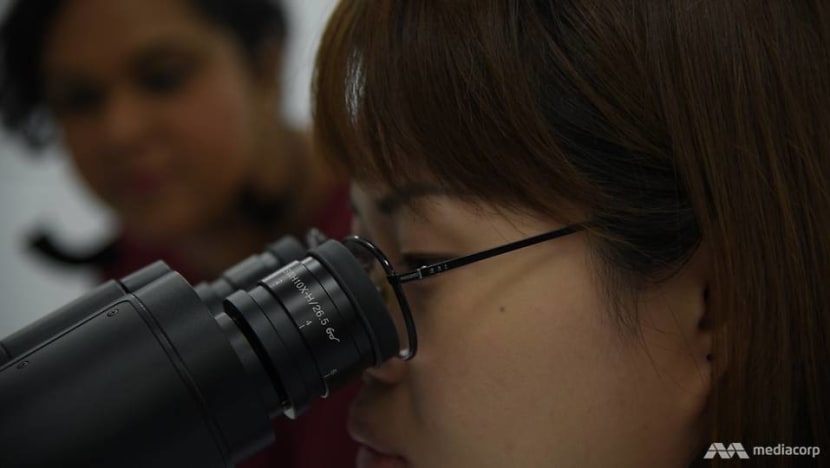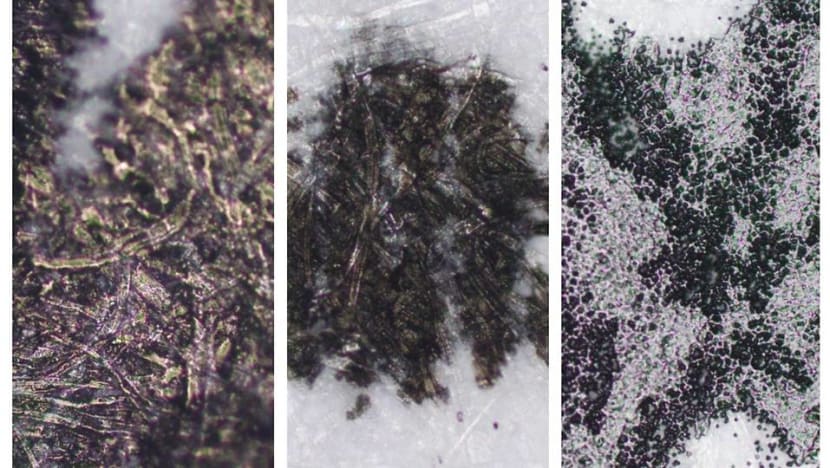'It's a different world under the microscope': HSA's crack team can tell authentic documents from the fake

Forensic scientist Ngor Yi Hui looks through a microscope. (Photo: Darius Boey)
SINGAPORE: If you were to very carefully forge a signature on a cheque, what are the chances the crime would be discovered?
If it passes through the doors of the forensic scientists at the Health Sciences Authority (HSA), then the chances are very high - possibly as high as 100 per cent.
That is because within HSA, which houses Singapore’s forensic capabilities, is a team that is trained to examine documents for forgery and other crimes.
READ: Man forged documents including NUS degree to get work, snagging 38 jobs in 4 years
The team handles 80 to 100 cases a year, the majority of which come from law enforcement agencies like the Singapore Police Force who submit material they need examined. Among the evidence that needs to be examined could be a degree certificate that is thought to be fake, potentially counterfeit bank notes, or even “O$P$” splashed on a wall in a loanshark investigation.
Other than the police, the team, which has eight members, also counts law firms and private individuals among its clients. They usually want documents like wills and business contracts analysed.
“We are specialised in forensic document examination and our analysis includes examination of handwriting, signature, ink, paper, printing, counterfeit, and alterations," senior forensic scientist Nellie Cheng told CNA at the team’s lab at HSA on Outram Road.
“It’s a different world under the microscope,” she said.
The lab is not unlike a kitchen, albeit a sterile one, with the tools the scientists need - microscopes, different lighting sources and image processing software - arranged neatly along two workbenches. An aisle separates the workbenches.
Alongside the microscopes are display monitors that show the magnified evidence. Outside the lab is the team's office, where the scientists work on other cases.
WHAT’S IN THE LETTER “H”?
The bulk of their work involves analysing handwriting and signatures, and they have their work cut out for them. Handwriting may need to be analysed on documents like threat letters and suicide notes, although such cases do not only include paper documents. If there is handwriting on a wall, table, dustbin, or mirror, these surfaces are also considered documents, Ms Cheng said.
Fellow forensic scientist Ngor Yi Hui explained how handwriting is analysed.
They examine the handwriting in the suspect document to note its features, and compare it to a specimen provided by the police. The process, however, may not be as straightforward as it sounds.
READ: Students graduating from local schools to receive ‘tamper-resistant’ digital certificates
“Some people write in a cursive manner (and) some write individual letters, so the way they connect the letters is one of the features we will see. Features like hand pressure and slant of the handwriting also vary,” Mr Ngor said.
She gave the example of the letter H. There are many ways the letter can be written, with various starting points and pen direction. The horizontal bar could protrude on the left or right, be short, or be slanted upwards or downwards.
“H is just one letter and we can look at so many different combinations and features, so can you imagine if you combine it with the rest of the alphabets?” she asked.
When it comes to signatures, a forger will try to mimic the original signature and it may even pass off as legitimate to the naked eye.

“But under a microscope - maybe because the person is attempting to copy - the handwriting may not be as smooth, and the hand pressure will differ. These are some features you can’t find just by doing a basic visual examination. We will need to examine it under the microscope to look at these features,” Ms Ngor said.
TINKLING WITH INK
Handwriting and signatures aside, the team also analyses ink - whether printed or written. Under a microscope, toner from a laser printer and liquid ink from an inkjet printer appear different. Different pens also produce distinctive features.
READ: Law graduate struck off the roll for forging her grades to get a job
Indeed, as CNA observed, under a microscope, pen ink looks like a tangle of leaves tinged with purple, ink from an inkjet printer has a smooth, even colour, and toner ink has a distinctive pattern that resembles a cell structure.
Printers could also have unique characteristics that provide tell-tale clues in investigations.
“For example, it could be an extra dot which appears periodically because of some defects from the printer,” Ms Cheng said.
In some cases, the forensic scientists do not have much to go on. In one particularly memorable case of a written threat, Ms Cheng recounted lifting indentation marks off blank pieces of paper seized from the suspect.
By examining the lifted indentation marks, Ms Cheng was able to compare the indentation marks to the written threat and assisted in linking it to the suspect.
She was unable to reveal more so as not to tip off any potential criminals.
She said the case was not easy because there were a lot of confusing details on the indentation marks that were being analysed. "It was kind of like a puzzle. We took a lot of time,” she said.
EXAMINING EVERYTHING A WORK HAZARD
The forensic scientists’ passion is palpable, and unsurprisingly, their work habits seep into their everyday lives.
Whether it is food packaging after they have finished eating, or new pens, they are hard-wired to think about them in relation to work, they said sheepishly. In fact, they examine new pen ink and printed food packaging under the microscope to acquaint themselves with how they look.
Once, Ms Ngor even put a card she received to the test.
“I once received a card from a friend. It was claimed to be painted by a certain person who does street art. I decided to see under the microscope, and found out that it was screen printing, which is used for things like mass production of t-shirts,” she said.
EVOLVING WITH THE TIMES
Ms Cheng and Ms Ngor said that the methods behind producing the faked documents they analyse have improved with technology, for example through the use of editing software like Photoshop, and more people using sophisticated printers which are now cheap and readily available.
Previously, efforts were more rudimentary, like physically cutting and pasting of paper.
However, the changing methods of forgery also present the investigators with opportunities. When documents are printed, there is a higher chance that the team will be able to associate the material with a specific type of printer, which would provide leads for the police.
They have also improved their methods. In a scenario where a bar is added to the number 1 so it becomes a 7, one of the chemical analysis methods was to take out a small portion of the ink of the bar using a scalpel and tweezer under microscope, dissolve it, and run a chemical analysis.
“The not so good side is that we will have to destroy a portion of the precious signature or document,” Ms Cheng said.
They now have more sophisticated methods which don't damage the evidence.
“In that scenario, maybe under infrared light, the two inks behave differently. Using alternate wavelengths of light, I do not need to take out the stroke,” she said.
FOR THE LOVE OF LEARNING AND JUSTICE
Like acquiring new skills in the analysis of ink, the learning never stops in their job, the forensic scientists said. Their enthusiasm remains unwavering.
“For questioned documents, the learning doesn't stop once we become competent. With technology, there are many different methods. There are endless things to learn,” Ms Ngor said.
For Ms Cheng, it is the knowledge that she is helping in the administration of justice.
She said: “Most importantly, I know that what I am doing can play a part in the administration of justice, however small. In fact it doesn't matter whether small or big, it is that I can play a part.”














